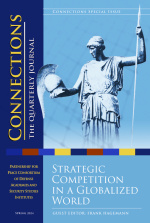Strategic competition is not new, nor is the use of activities short of warfare by governments to shape the international system in their favor. However, the ability of state and non-state actors to directly influence populations through a range of rapid and non-attributable actions is different from previous iterations of strategic competition. These activities, referred to in this article as hybrid threats, directly challenge state sovereignty and represent the key distinguishing feature of contemporary strategic competition. To clarify this argument, the article aims to provide working definitions of strategic competition and its distinction from great power competition; to explain what hybrid threats and hybrid warfare are and their roles in the broader strategic objectives of state and non-state actors; to describe how strategic competitors and adversaries perceive these activities; and to emphasize the importance of building resilience within populations to counter hybrid threats.
Reviewed article
Hybrid Threats and Strategic Competition
Article statistics
Bibliography
“269. Policy Planning Staff Memorandum,” Office of the Historian, May 4, 1948, https://history.state.gov/historicaldocuments/frus1945-50Intel/d269.
“Countering Hybrid Threats,” NATO, August 18, 2023, https://www.nato.int/cps/en/natohq/topics_156338.htm.
“Extracts from Putin’s Speech at Annexation Ceremony,” Reuters, September 30, 2022, https://www.reuters.com/world/extracts-putins-speech-annexation-ceremony-2022-09-30/.
Al-Kassab, Fatima, “What Is the ‘Axis of Resistance’ of Iran-Backed Groups in the Middle East?” NPR, October 26, 2023, https://www.npr.org/2023/10/26/1208456496/iran-hamas-axis-of-resistance-hezbollah-israel.
ARIS, “Little Green Men”: A Primer on Modern Russian Unconventional Warfare, Ukraine 2013-2014 (Fort Bragg, NC: The United States Army Special Operations Command, 2018), https://www.soc.mil/ARIS/books/pdf/14-02984_LittleGreenMen-UNCLASS-hi-res.pdf.
Ayres, Alyssa, “How the BRICS Got Here,” Council on Foreign Relations, August 31, 2017, https://www.cfr.org/expert-brief/how-brics-got-here.
Bakir, Ali, “Turkey’s Defense Industry Is on the Rise: The GCC Is One of Its Top Buyers,” Atlantic Council, August 4, 2023, https://www.atlanticcouncil.org/blogs/menasource/turkey-defense-baykar-gcc-gulf/.
Barrett, Richard, “Beyond the Caliphate: Foreign Fighters and the Threat of Returnees” (New York, NY: The Soufan Center, October 2017), https://thesoufancenter.org/wp-content/uploads/2017/11/Beyond-the-Caliphate-Foreign-Fighters-and-the-Threat-of-Returnees-TSC-Report-October-2017-v3.pdf.
Borrell, Josep, “Russia Must Stop Using Food as a Weapon,” European Union External Action, August 2, 2023, https://www.eeas.europa.eu/eeas/russia-must-stop-using-food-weapon_en.
Chakravorti, Bhaskar, and Gaurav Dalmia, “Is India the World’s Next Great Economic Power?” Harvard Business Review, September 6, 2023, https://hbr.org/2023/09/is-india-the-worlds-next-great-economic-power.
Finley, Mark, and Anna B. Mikulska, “Wielding the Energy Weapon: Differences Between Oil and Natural Gas” (Houston: Rice University’s Baker Institute for Public Policy, June 26, 2023), https://doi.org/10.25613/G9P2-3F78.
Galeotti, Mark, The Weaponization of Everything: A Field Guide to the New Way of War (New Haven: Yale University Press, 2022).
Garamone, Jim, “Dempsey: U.S. Forces Must Adapt to Deal with Near-Peer Competitors,” Joint Chiefs of Staff, August 17, 2015, https://www.jcs.mil/Media/News/News-Display/Article/613868/dempsey-us-forces-must-adapt-to-deal-with-near-peer-competitors/.
Hoffman, Bruce, “Rethinking Terrorism and Counterterrorism Since 9/11,” Studies in Conflict & Terrorism 25, no. 5 (2002): 303-316, https://doi.org/10.1080/105761002901223.
Hybrid CoE, “Hybrid Threat as a Concept,” https://www.hybridcoe.fi/hybrid-threats-as-a-phenomenon/.
Kalin, Stephen, “Gaza Diplomacy Cements Qatar’s Global Mediator Role,” The Wall Street Journal, November 25, 2023, https://www.wsj.com/world/middle-east/gaza-diplomacy-cements-qatars-global-mediator-role-29e0ffb7.
Kilcullen, David, The Dragons and the Snakes: How the Rest Learned to Fight the West (New York: Oxford University Press, March 2020).
Mahood, Samantha, and Halim Rane, “Islamist Narratives in ISIS Recruitment Propaganda,” The Journal of International Communication 23, no. 1 (2017): 15-35, https://doi.org/10.1080/13216597.2016.1263231.
Michael J. Mazarr, Bryan Frederick, and Yvonne K. Crane, Understanding a New Era of Strategic Competition (Santa Monica: RAND Corporation, November 2022), https://www.rand.org/pubs/research_reports/RRA290-4.html.
Nilsson, Niklas, et al., “Security Challenges in the Grey Zone: Hybrid Threats and Hybrid Warfare,” in Hybrid Warfare: Security and Asymmetric Conflicts in International Relations, ed. Mikael Weissmann et al. (London: I.B. Tauris, 2021), 2, https://doi.org/10.5040/9781788317795.0005.
North, Douglas C., “Institutions,” Journal of Economic Perspectives 5, no. 1 (Winter 1991): 97-112, https://doi.org/10.1257/jep.5.1.97.
Nye, Joseph S., Soft Power: The Means to Success in World Politics (New York: Public Affairs Books, 2005).
O’Dell, Hope, “Why Is Sweden Telling Its Citizens to Prepare for War?” Chicago Council on Global Affairs, January 24, 2024, https://globalaffairs.org/bluemarble/sweden-tells-citizens-prepare-war-russian-aggression-nato-membership.
O’Rourke, Ronald, “Great Power Competition: Implications for Defense – Issues for Congress,” Congressional Research Services, October 3, 2023, Report, R43838, https://sgp.fas.org/crs/natsec/R43838.pdf.
Parham, Jason, “Targeting Black Americans, Russia’s IRA Exploited Racial Wounds,” Wired, December 17, 2018, www.wired.com/story/russia-ira-target-black-americans/.
Payne, Christian, and Lorraine Finlay, “Addressing Obstacles to Cyber-Attribution: A Model Based on State Response to Cyber-Attack,” The George Washington International Law Review 49, no. 3 (2017): 535-568, https://149801758.v2.pressablecdn.com/wp-content/uploads/_pda/ILR-Vol-49.3_Panye-Finlay.pdf.
Robinson, Linda, et al., “The Growing Need to Focus on Modern Political Warfare,” Research Brief RB-10071-A (Santa Monica: RAND Corporation, 2019), https://www.rand.org/pubs/research_briefs/RB10071.html.
Roepke, Wolf-Diether, and Hasit Thankey, “Resilience: The First Line of Defence,” NATO Review, February 27, 2019, https://www.nato.int/docu/review/articles/2019/02/27/resilience-the-first-line-of-defence/index.html.
Thomas, Mark, “The Chinese Roots of Hybrid War-fare,” CEPA, August 10, 2022, https://cepa.org/article/the-chinese-roots-of-hybrid-warfare/.
U.S. Department of Defense, “Summary of the 2018 National Defense Strategy of the United States of America: Sharpening the American Military’s Competitive Edge,” https://dod.defense.gov/Portals/1/Documents/pubs/2018-National-Defense-Strategy-Summary.pdf.
Wardle, Claire, “Understanding Information Disorder,” First Draft News, September 22, 2020, https://firstdraftnews.org/long-form-article/understanding-information-disorder/.
Warner, Jason, et al., The Islamic State in Africa: The Emergence, Evolution, and Future of the Next Jihadist Battlefront (New York: Oxford University Press, 2021), https://doi.org/10.1093/oso/9780197639320.001.0001.
Weissmann, Mikael, “Conceptualizing and Countering Hybrid Threats and Hybrid Warfare: The Role of the Military in the Grey Zone,” in Hybrid Warfare: Security and Asymmetric Conflicts in International Relations, edited by Mikael Weissmann et al. (London: I.B. Tauris, 2021), 65-66, https://doi.org/10.5040/9781788317795.0011.

